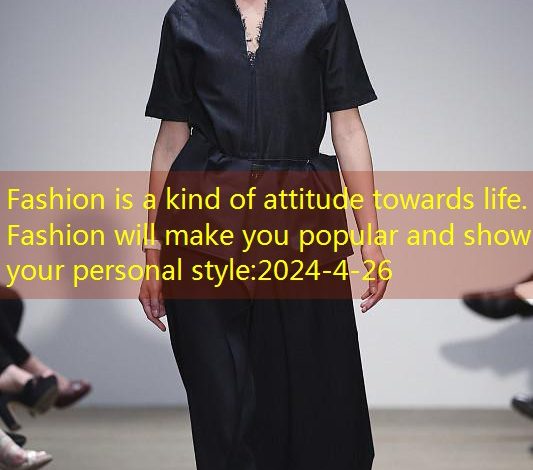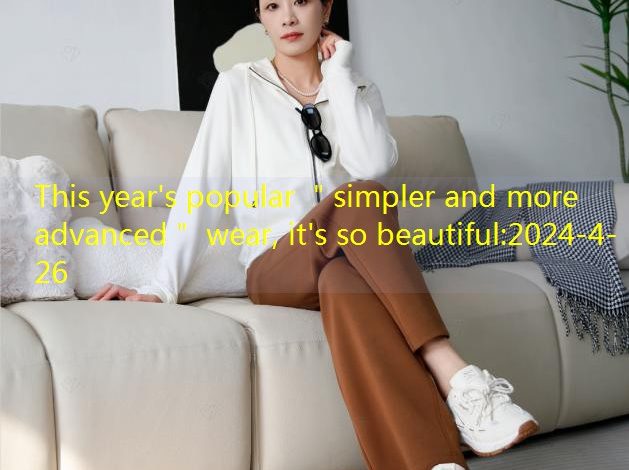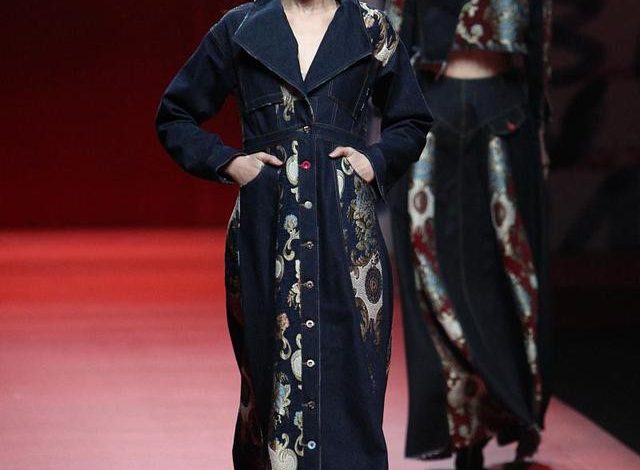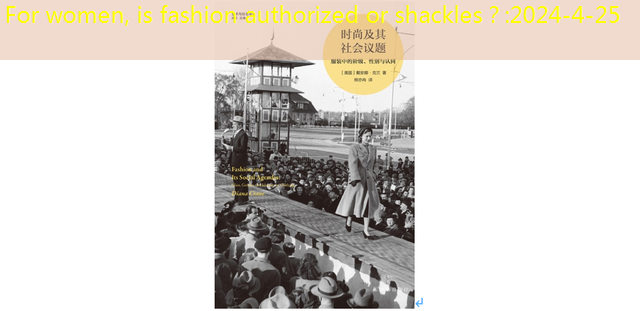
For women, is fashion authorized or shackles?
Today, it is well known that the information revealed by fashion is far from the visual style and aesthetic choice. According to the scholar Wang Dewei, “Fashion is the interface of the body’s skin and the world contact, the” shuttle ‘and the public field,’ ‘Practice ‘material life and consumption imagination. “
American cultural sociologist Diana Cran has recently published the book “Fashion and Social Topics: Class, Gender and identity in clothing”.In her opinion, every person’s lifestyle, gender, age, race and other factors are an important basis for building their wardrobe.
The following is authorized by the Publishing House to exceed the third chapter of “Fashion and Social Topics: Class, Gender and identity in clothing”.Clan discussed the emergence of alternative clothing in the text, how to break the boundaries of women’s body expression in public space, and how to interact with the women’s liberation movement at the time.Limited by space, there is a deletion compared to the original text, and the title is proposed by the extractor.
For women, is fashion authorized or shackles?Perhaps as Kramus said in the book: fashion is always a social issue of women, and dressing behavior is always out of social motivation.If a woman thinks her appearance and identity as a continuous evolutionary plan, then her choice of consumer goods will become a complex negotiation process: from conflicting hegemony specifications transmitted by media images to her own gender to genderDifferent understanding.
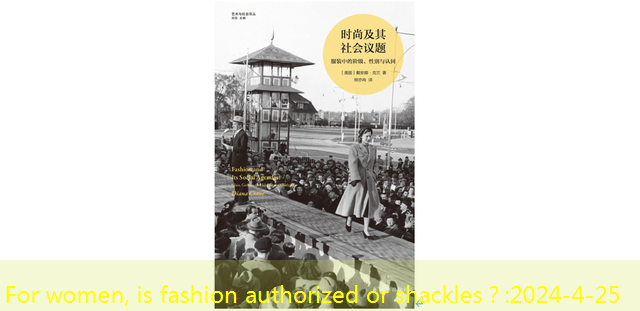
“Fashion and Social Topics: Class, Gender and identity in clothing”, [beauty] Diana Cran, Xiong Yirani translated, translation Lin Publishing House, February 2022.
Original Author | [戴] Diana Calan
Excerpt | Qingqingzi
Tie, straw hat and suit jacket:
Women’s Movement in the History of Clothing
Although the fashion style originated from France, the influence of Britain on alternative styles is beyond doubt (especially in the design of sportswear and custom suit jackets), which shows the acceptance of British culture to alternative female images.This may be affected by the tradition of British women’s rulers and reflected in the 19th century Queen Victoria.In 1837 (the first year she was in reign), Victoria wore a male military hat, wearing blue military uniforms, and reviewed her army in Windsor.
The alternative style can be understood as a set of symbols that inherit men’s clothing. It consists of single or commonly used items, and cleverly changes the overall effect of women’s clothing.Men’s tie is one of the most common alternative costumes.The importance of tie in alternative styles is related to its role in men’s costumes.Kippins pointed out that in Victorian society: “Everyone’s tie announces their current social status … and ambitions.” As the men’s clothing in the 19th century became more darker and stereotyped, the tie was used to encode the outfiter’s origin background, That is, the “legion, club, sports or educational background”.Although female wearing tie is an independent expression in a general sense, it will also be related to different alternative lifestyles.The novel “Cranford” of Elizabeth Gaskell (Cranford) described the role of unmarried women (representing the real etiquette) as the background of the British town in the 1840s as the background of the 1940s.”Tie and a small hat like a jockey hat.”
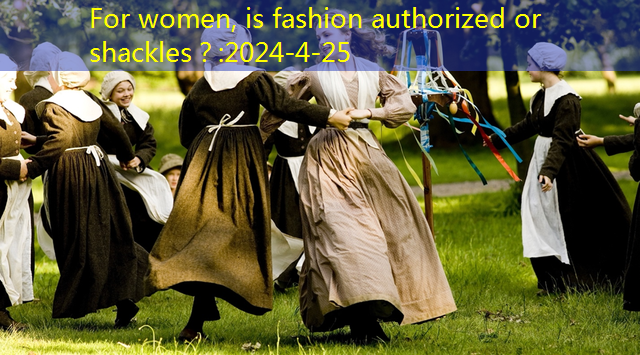
Stills of the British drama “Clade”.
In 1851, the daughter of the clothing reformer Amelia Bloomer was said to wear a dark red silk tie with a pale purple waist top and white trousers.At this time, photos of the middle class and women of the upper class that have begun to appear at this time can indicate the different meanings conveyed in the tie.In 1855, an anonymous photographer took a photo of a young woman. She wore four different styles of ties as fashionable accessories at the time: “Lace collar, butterfly brooch fixed collar, and … have a sense of design.”Men’s butterfly bow tie”, in addition, wearing a necklace.The Camp Nington mentioned that women’s collars and ties were “very conspicuous in 1861.”In 1864, a British woman took a photo with the seaside as the background. She wore a tie, a very loose skirt and a coat that echoed the style of men’s jackets at the time.It is worth noting that in 1876, a photo of the University of Wisconsin (almost the same as the women and men in the photo) showed that all young women wearing some styles of tie.
Since the 1870s, many young women wear black velvet neck belts.The width of the neck ranges from 0.25 inches to 0.5 inches, which is very similar to the black tie (1 -inch width) worn by men in this period.At the end of the 19th century, members of all social classes (including women in high society) wore satin leaders, although the history of French fashion has almost never mentioned the existence of satin leaders.Middle -class women match it with business uniforms, school uniforms and nurse uniforms; worker class women wear them with servants and nanny uniforms, as well as workwear in the factory.Various ties are usually part of sportswear, especially in the last decade of the 19th century.By the end of the 19th century, there were more and more photos of women wearing tie in the above three countries.Women of wearing tie have also begun to appear in painting works. This is a sign of improvement of social recognition, because portrait paintings are much more formal than photography.
Kingsberg believes that the tie is the core of the “feminist uniform” in the 1890s, and described the wearing a young woman: “tall, stiff, buckle collar and ordinary tie with small pearls.The firm claim of equality between men and women marked the attack on men’s privileges. “At the same time, Kingsberg pointed out that the young woman brought her thin waist with wide waist and tied a big bow on her long hair.In this way, “euphemistically take care of your choice.”She wore a wide -sleeved shirt and slim skirt to conform to the fashion trend at the time.Wearing a tie is a social statement that can also be seen in the example of French novelist Colette.In 1900, Kolt took a group photo with her husband, she was wearing a traditional costume of middle -class women -wearing a daisy hat, wearing a lace shirt and a necklace.A few years later, she was photographed with a long tie when she separated from her husband and did not wear a hat.
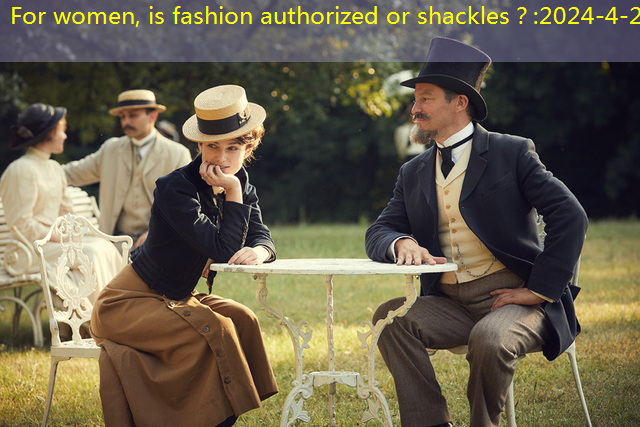
Stills of the movie “Kolt”.
The hat is also a powerful symbol of male identity, and was favored by women during this period.Since the 1830s, people have the habit of ride hats of wearing a hat. This habit has continued the whole century. By the end of the 19th century, people began to wear a dome hat when riding.Women wearing a men’s hat in other activities began in the middle of the 19th century.Sailor straw hat was originally a fashionable children’s hat, but in the 1960s, it gradually became female fashion.According to Bruce, the Derby hat (dome cap) was popular in the 1970s, “almost exactly the same as a men’s hats.”At the time, Alexandra, Princess of Wales, was photographed in a dresses and a narrow round cloth hat in a afternoon dress.In the 1880s, there was the same soft woolen hat as men.During this period, women wore men’s hats, hunting hats and yacht hats during exercise.
In the 1880s, the hard straw hat (or flat -top hard straw hat) became extremely popular as a men’s hat. In the next thirty years, women generally wore this hat.It is very popular among men and women, and it can be said to be a “neutral” accessory.这种有着精确的几何线条且设计简洁的帽子,与此时女帽的典型款式形成了鲜明对比,当时的女性通常戴着面纱,并在帽子上堆满鲜花、缎带、蕾丝、羽毛、小Bird -style decoration, sometimes the decoration of crawled animals, shellfish and insects.The flat -top hard straw hat with a tie and a suit jacket expresses the independence of young women in new occupations such as office work.Wearing a men’s jacket on the maid costume and bearing the bow, it constituted a gesture of resistance at the time.
The suit jacket is called “the symbol of women’s liberation in the 19th century”.With the development of the times, the conciseness of women’s suits and the increasingly complicated fashion of women’s suit jackets form a sharp contrast.In the 17th century, women in high society wore jackets to ride and walk in rural areas.In the first half of the 19th century, skirts dominated fashion, but in the middle of the 19th century, jackets became popular again in rural or seaside.Loose jackets and imitation men’s jackets are matched with short tops, butterfly neck collar and straw hat with a masculine shirt collar.These styles originated in Britain, and Britain at the time was already the leader of men’s style.In the 1860s, although the “men’s double -breasted jacket” was very popular, it was not respected by people.In 1874, Princess Alexandra was photographed in the women’s version of the naval officer uniform.In 1877, the imitation version of Norfolk Jacket became popular in the UK.In the United States, women’s participation in the civil war promoted the development of male -based sets, including “dark jackets, short skirts and plain shirts.”They have been wearing such sets in the following decades.
In the 19th century, the alternative style of dress is incorporated into more and more items, and the items itself is continuously developing, especially for suit jackets.But even at the end of the 19th century, women were choosing this style.Wearing collars and straw hats means a state of not strong enough.With a living tie, wearing a men’s shirt, vest, and tailored jackets and sailor clothes, or wearing a male hat, these are strong declarations.In all classes of society, women and workers in society, you can see this style.The alternative and mainstream styles of dress form a clear contrast in the photo.
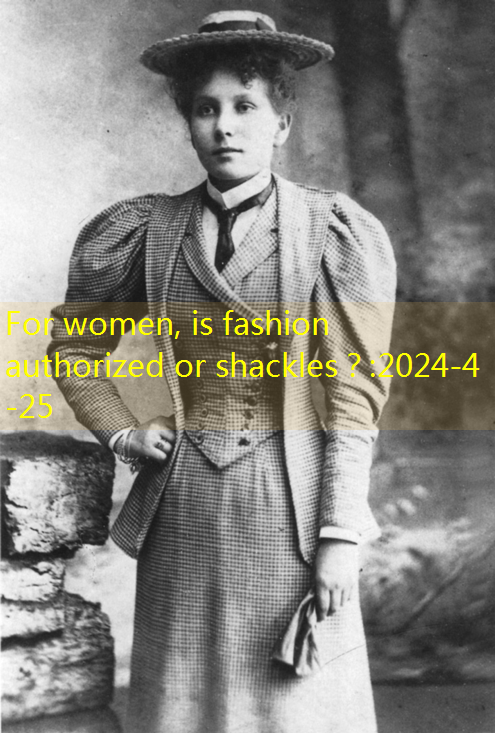
Middle -class women are wearing “alternative” clothing.Photos are provided by publishers.
The portrait photos of the two French amateur female photographers illustrate the relationship between dress and self -image.The first woman named her photo “amateur photographer”, and she wore a mainstream women’s clothing in the 1890s.Fifteen years after the second woman, she wore an alternative style: imitation male female shirt with butterfly knotted.It is worth noting that she took a posture with a professional photography magazine, probably to show her recognition of her professional skills.As a professional woman, she is the principal of a private boarding school.
It is important that these men’s clothing is always combined with women’s clothing, and this dressing method has not been rejected by society.It was not until the beginning of the 20th century (especially in the 1920s) that the suit jacket worn by women began to have lesbian connotation.In contrast, as the first female assistant surgeon in the Federal Army, Dr. Mary EdwardS Walker chose men’s trousers and long dresses, but this style of dressing made her quite equivalentGreat hostility.Congress has approved a special law to grant Walker’s right to wear pants.
How did women understand these men’s clothing in the 19th century?Are these items “lost the original meaning” as Perot said?Women incorporate the frequency of men’s elements into women’s clothing, the facts that are attacked by do not eliminate the masculinity, and the way of this dressing behavior across the boundaries of the social class all shows that these items constitute a symbolic statement about women’s status, and as well asFitting throughout the 19th century about women’s status.
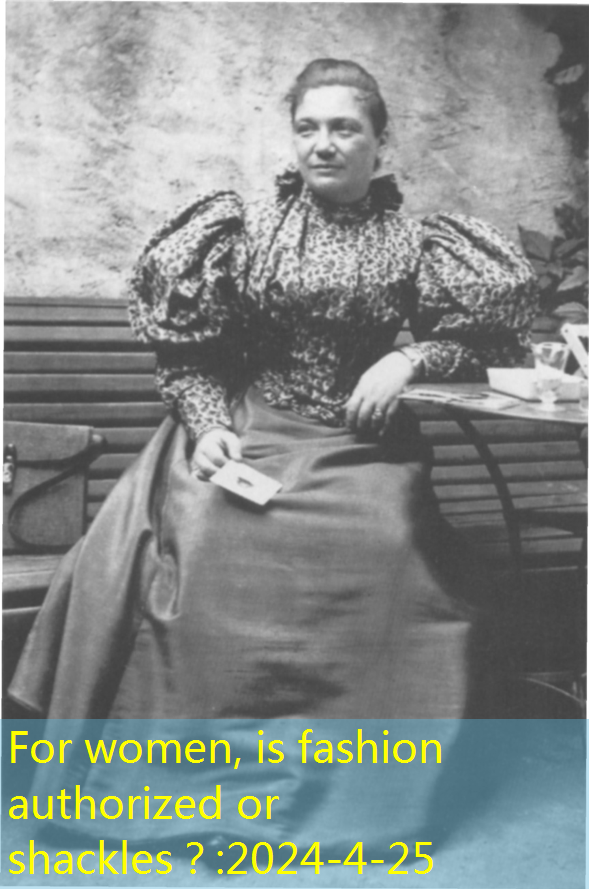
Selfie of female fashion photographer.Photos are provided by publishers.
After the First World War, alternative styles such as tie, men’s hats, men’s jackets and vests are no longer in sharp contrast to mainstream styles.In the 19th century, the ideal (sexy women), who dominated by the dominant position, had been replaced by independent and really young women. These young women had a boy -like image and combined some characteristics of mainstream women and alternative women in the last century.In terms of the former represents a weak and helpless feminine temperament, the latter represents self -confidence and sports spirit.The alternative style is no longer a opposite style.The items (especially the suit jacket) are now part of the mainstream style.After the First World War, a new alternative style appeared. It was related to lesbians in New York, London and Paris, but this style did not be extensively imitated outside of these circles.This style is closer to “wearing heterosexual clothing”, not to associate certain men’s clothing with women’s clothing.
The appearance of a bicycle,
Change people’s attitude towards women’s sportswear
In the 19th century, Europe and the United States demanded that women should be packed on the streets and in other people’s homes. However, in some public places, women can still blur the symbolic boundary through alternative clothing.In the last thirty years of the 19th century, more and more venues (such as schools and vacations) can be used as women to avoid mainstream dressing specifications and obtain alternative identities with clothes.When the streets on the street wearing skirts outside their pants and proposed to use them as ordinary clothing, they were severely criticized, but the sports uniforms used in schools, universities and nursing homes are very similar. People can accept the latter obviously obviouslyIt is because it does not appear on the streets of the city.The rules of dressing behavior in public places show a slight difference due to the differences in place, class, and gender.For example, women can wear pants when swimming in the sea, but they cannot wear it like this when walking on the beach.In the second half of the 19th century, the introduction of the new movement (especially the bicycle movement) redefined the way to express symbolic boundaries in public space.In a sense, wearing alternative clothing in public places is a manifestation of more radical changes that exist in more hidden spaces.
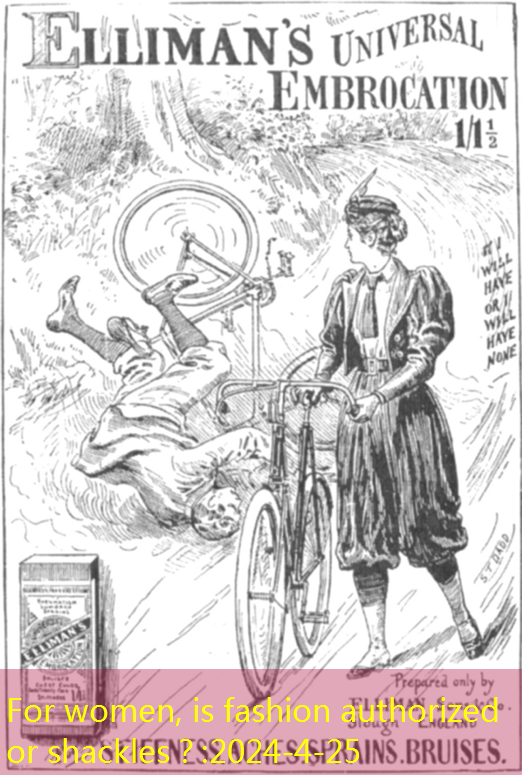
Bicycle ride installation.Photos are provided by publishers.
Before the 20th century, sports in women’s leisure activities were almost only retained for high society.Women’s dress when participating in these movements depends to a large extent on the nature of their public places.If sports activities are carried out near home or social clubs, women’s dressing standards are usually met.Tennis, hammer, skating and golf are regarded as social instead of sports.Therefore, in the 1870s, people hoped that women to participate in these sports are the same as other social occasions: long skirts, body clothes, skirts and big cuckers.When they move inside or countryside, their sports may also include masculine clothing.The women’s college provides such an environment: women can carry out male movements (such as baseball) without seeing people.Sports is regarded as “male territory” and is a way to prove masculinity.As a result, women who participate in male movements in public are vulgar and even immoral.
Riding is one of the earliest entertainment activities for women in high society.In the mid -17th century, women’s riding clothes worn in rural rural riding, walking and traveling included “a coat with a skirt wearing a man at that time, a similar neck tie, a wig and a triangular hat on the head”.It is worth noting that these masculine clothes are usually paired with long skirts and various lining skirts.In the 19th century, women continued to wear horses from men’s dress, but they were mainly for horseback.In 1850, women’s “side saddle ride” (SideSaddle Ridding, a special way of riding a European lady) style was made by men’s tailors instead of women’s tailors.Long skirt design.By the 1880s, most women were paired with slender dark straight pants under the skirt.They also wore men’s silk high hats, jockey hats and straw hats.It wasn’t until the First World War that people thought that it was more suitable for crossing.The horse pants are made by professional tailors according to the style of men’s horse trousers, and it was not until 1900 that more women wearing horse pants.The evolution of horse riding clothes reveals the degree of men’s acceptance of men’s dresses, which even includes all kinds of pants that are completely inconsistent in other circumstances.
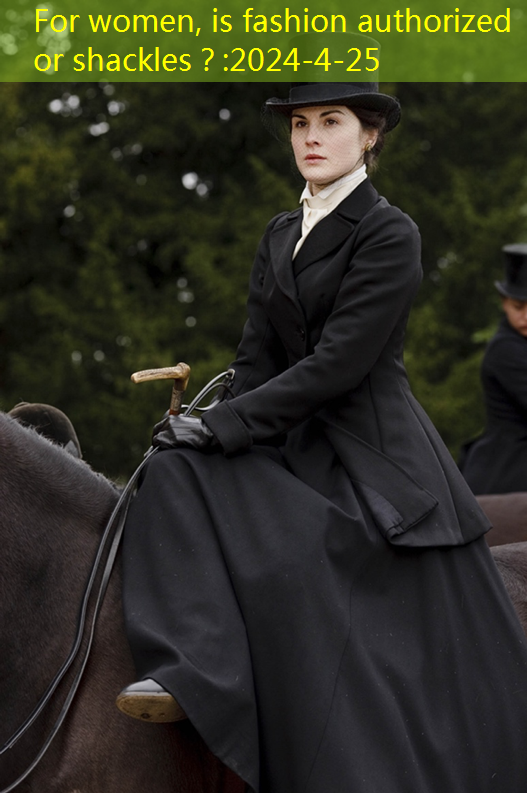
British drama “Downton Manor” (first season) stills.
The swimsuit belongs to another field, and women in high society can launch less appropriate dressing behavior here.Lenkek and Bosk describe the summer resort as “fashion laboratory, where rich people can try new dressing and behavior.”As early as the 1860s, the women’s swimsuit chose shorts or lantern pants that cannot be worn in other public places, and paired with the waist jacket.Byrde quoted the magazine at the time, thinking that young women wearing such clothes was like “beautiful boys.”In the United States, people usually wear skirts on the outside of their pants and ankle.Socks can be matched at will.By 1909, women’s swimsuit almost changed.Although the types of bodies are usually much less than outdoor, it is still highly respected.
At this time, people want women to wear on the beach as usual (long -sleeved shirts, mop long skirts, bodies, large hats and gloves), and photos show that most of them are indeed.The ocean itself is defined as a threshold space, and general clothing (and moral) standards are not applicable.The use of seaside wooden houses strengthened the obvious separation of the ground and the water. Women replaced the swimsuit there, and thus to the sea.It can be seen from the photos that when the dressed women are wading by the seaside or the river, their legs are not unusual, which is in sharp contrast to the specifications of the skirt always covering the ankle.
Young women provide an alternative clothing discourse in school uniforms worn by middle schools or universities, which are often more effective than clothing reformists, because it may be the dress of most women.In the middle of the 19th century, the opening of American Women’s University coincided with the popular health and exercise.The university adopts the sports plan that students must participate and their corresponding dress, which may be designed for them.These schools of clothing are sportswear and knee skirts, and black cotton stockings.It is worth noting that this type of sportswear is limited to exercise and cannot be worn in public.If the students may appear in the public view, they must wear skirts.In any case, the mainstream fashion magazines at that time wrote articles about sportswear and explained the production process.The style of sportswear was popularized at the end of the 19th century.
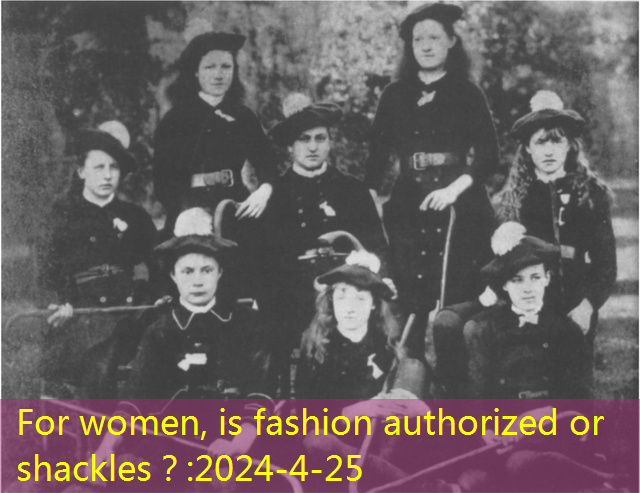
Female students in sportswear.Photos are provided by publishers.
The school uniforms mainly used for sports activities have played an important role in introducing non -restricted dressing in the UK.The principal of the women’s school is very clear about their role as a clothing reformeer.In 1877, a school in Scotland (“” The Grade of many Women’s Schools in the UK in the future “) launched a set of school uniforms, including” blue and knee waist coats, below with lantern pants [and knee lantern pants] or trousers “, this kind of type”, this kind of long, “, this is this kind ofClothing is the pioneer of fashion in the 1920s.
Compared with the United Kingdom or the United States, French women are more controversial in sports.Popular magazines believe that if women wear elegant and fashionable and not loser women’s temperament, then participating in sports activities will not lead to too much criticism.A law adopted in 1880 requires public boys to offer gymnastics, but this has become an elective course in the women’s school.The product directory of a department store in Paris published an advertisement of adolescent girls in and knee -knee long trousers and gymnastics. At the end of the 19th century, female teachers in a teacher training school in Paris were photographed in fitness classes to cover the ankleThe black long skirt.
The influence of bicycles on the dress behavior of the 1990s originated from it as a new movement, so it was not regarded as a male activity.This is also a private activity in private; because it requires space and public roads, although female riders in the early upper -class society try to move alone in the park.The earliest female cyclists in the UK were women in the high society, and they took a carriage to London Park to ride a bicycle.Bicycle cycling is different from the previous entertainment activities, because wearing the fashion at the time could hardly ride a bicycle.
The most suitable cycling dress is a skirt. It looks like a skirt, but it is actually knee shorts and lantern pants.With the popularity of bicycles in the United States, crab pants have been popular for two years (1895-1897), but it soon disappeared.In most cases, the lantern pants are matched with skirts.If women do not wear skirts, they will be “laughed and contempt.”By the end of the 19th century, the solution that people can accept is to wear shorter skirts.In the 1890s, women have started wearing short skirts in the summer fake, but in the mid -1990s, the first batch of women wearing and ankle skirts still encountered hostile crowds.Some women in the UK are wearing lantern pants; others are wearing special styles of skirts. This kind of skirt can be buckled into the shape of the pants on the leg when riding a bike.Outside of urban parks and villages, people are quite conflict about this costume, especially in the working class: “Female Rider in the” Rawnishment Association ‘”In urban areas) … the more poor people are, the more angry it is. “
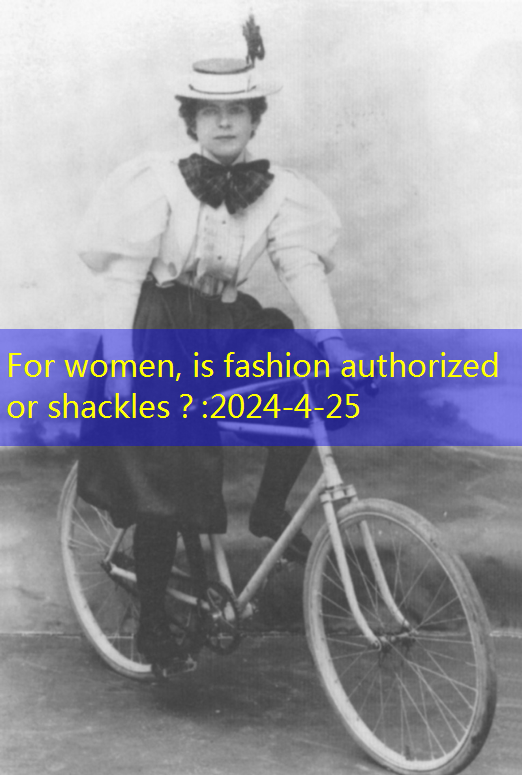
A French woman riding a bicycle shot her bicycle and cycling in the photographer’s studio, including the knee -on -knee skirts, straw hats and fashionable wide -sleeved shirts (about 1895, France).Photos are provided by publishers.
Strangely, in France, sportswear was not known before the emergence of bicycles, and women rarely participated in sports activities, so the dresses worn by female riders were soon accepted.In 1892, only four years after invented a widely popular and safe -performance and safety of performance, the Minister of the Interior promulgated a decree to ban women’s pants. This ban can only be lifted when riding a bicycle.As early as 1893, a department store in France began to sell pants skirts or covered his pants with short skirts.Most women wear skirts outside the lantern pants, or wear pants skirts.However, the controversy about this kind of dress is far from being as intense in the United States.The reason seems to be that this activity is mainly for the most upper -level society.Or ride on the seaside instead of the streets of the city.
According to Monier 1990: 121, 125), bicycles have become “one of the symbols of liberation”, which completely changes people’s attitude towards women’s sportswear.She claims: “In fact, this kind of well -known bicycle appears in this form: it determines the moment of modern concepts that can evoke people’s modern concepts of dressing, women’s shorts, women’s liberation, and freedom …” However, French designThe proposal proposed by the teacher in daily activities in 1911 still triggered controversy.Wearing this kind of pants in the game will cause extremely negative reactions.People cannot accept ordinary women wearing trousers on the street.
Workers class women:
Victorian Time Think of Women’s opposite
Workers’ class women are almost unable to participate in sports and sports, but they still break the customs of public places stipulated in the Victorian era.They work or employed public places are usually relatively “invisible” for the middle class, such as coal mines, remote rural or seaside, so these places allow them to wear pants and other male clothing.At the same time, the worker class women also need to meet the same etiquette standards as middle -class women without exception.
Costume historians recorded the situation of British workers’ class women wearing trousers, knee -horses, jackets and men’s hats for several centuries.In the 16th century, British women working in coal mines began to wear knee -horses.In the 17th century, women who collected shells on the sea would “tied them into horse trousers” to imitate their pants.In the 19th century, this approach continued, because others would “wear and knee shorts under the skirt, coupled with sailor jackets and tie -chin headscarves.”During the same period, workers’ class women wore knee -horses, trousers and jackets in coal mines, steel plants and brick factories.Except for women working in British coal mines, most of these cases have almost failed to attract people’s attention.
In 1841, about 5,000-6,000 women worked in the mine in Britain.Women in some areas are wearing unique clothing, including trousers, striped cotton apron or skirts tied to the waist, opening shirts, vests and wooden shoes.When the cold is freezing, they are either wearing a jacket of traditional rural women, which is known as the “robe”, or wearing short coats borrowed from male relatives.They wearing cotton hats or scarves, followed the Victorian headgear norms.It is usually equipped with earrings, necklaces, flowers and feathers.However, most women are still wearing typical dresses of that era on Sunday.As close to the mining, the environment of the mining area is isolated from other British workers’ classes, and non -traditional work clothes have developed.Men and women here are neither marrying other British workers nor interacting with them. Therefore, they are regarded as “abandoned children” and “barbarians”, but this is a potential threat to mine owners.
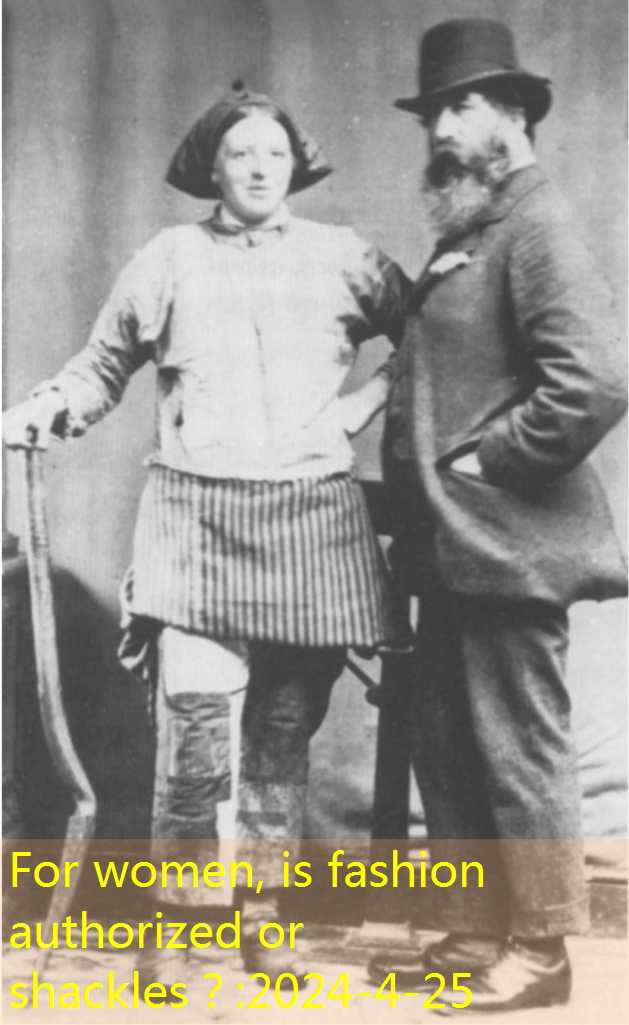
Vegan Coal Mine Girl in 1873.Photos are provided by publishers.
The costumes of these women have attracted the attention of the press, because their male colleagues tried to prohibit employment from hiring women to keep their jobs.In 1842, a sensational government report recorded the nature, working conditions and dressing characteristics of women’s work, and then formed such regulations: It is strictly forbidden for women to work under the mine, but work on the mine is still acceptable.In 1865 and 1887, male miners had incited and tried to prohibit women from working at the entrance of the mine, but the move failed to succeed.
Some newspapers depict these women as the opposite of the Victorian era: their clothes (especially pants) are regarded as “gender”.If they are not dressed properly, they will no longer be women, but they will become indecent, immoral, and disgusting “creatures”.Most of the articles in newspapers aims to call for their work to completely ban their work.At the same time, the photos of these women still have a considerable market, usually in the form of popular “Cartes De Visite.”Several photographers specializing in and selling such photos said that the public is not available for these photos.
In the 1880s, the middle -class clothing reformers began to defend the clothing of coal mines.At this time, sports are changing the dress of the high society, which makes their costumes no longer so rebellious.In a certain area at the end of the 1880s, this dress was tailor -made for female coal mines: “dark blue flavor jackets, beep trousers and long apron.”
During the First World War, some other types of public places provided such an environment: Workers’ class women do not have to follow the practice of costume behavior.British women wearing men’s uniforms (including jackets, ties, hats and long skirts) when they were serving.In the civilian life after retirement, they take over the various work of men, so they are usually worn -related uniforms.A large number of women working in the military fire plant also wear work clothes: canvas pants and blouses.British farm women wearing workers, trousers, trousers, or skirts, tight horse pants inside.Demali commented: “Officials do not want women to wear trousers, so as far as hats and jackets are concerned, the female inspectors on the railway look masculine, but they usually wear skirts below.”
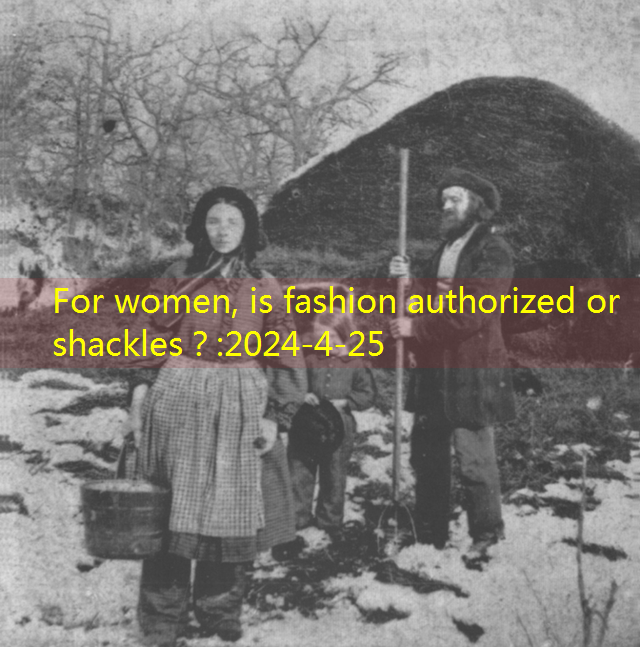
The improvement of the frontier farm faces the dress.Photos are provided by publishers.
In the United States, the unconventional dress behavior of the worker class usually appears in the “hidden” space (border).When working in remote areas, people often wear lantern pants.Although most middle -class women have abandoned this costume due to social pressure, the working class women continue this dress on the farm.This outfit is usually converted from a standard dress, including the tube pants legs made of the same fabric.
The public space that is far from “civilization” is the wilderness of Alaska.The photos taken at the end of the 19th century showed that women who trek in the area wearing men’s trousers, men’s hats, and women’s tops and bodies were paired.These women may be prostitutes, and their appearance is amazingly similar to modern style.In contrast, during the First World War, when the worker class women in the United States were engaged in heavy industrial labor, they needed to wear “special ‘feminine’ pants uniforms” or do it on the basis of Bulumer clothing.The long and loose lantern pants.
Although the law does not allow French women in the 19th century to wear trousers, this does not hinder the working class women.On the contrary, the ban made such behavior almost unknown.To what extent French women have also engaged in work corresponding to men’s clothing?In 1810, the law banned women from engaging in underground coal mines, but the law was not executed (Riot-SARCEY and Zylberberg-Hocquard 1987).French women are also engaged in transportation at the entrance of northern France, but the proportion of employees they represent is small, and this number has steadily declined after 1860.Women seem to work in mining and other heavy industrial fields, but compared with Britain, they have not left related image records.Some women in pants suggest this point. The women in the photo wore similar long trousers to the neighboring Belgian coal mines to transport coal.It is worth noting that Zara, who is well versed in the creation of novels, described the heroine as the image of men’s clothing (including trousers) in GERMINAL. This novel based on French coal mines was published in 1885.
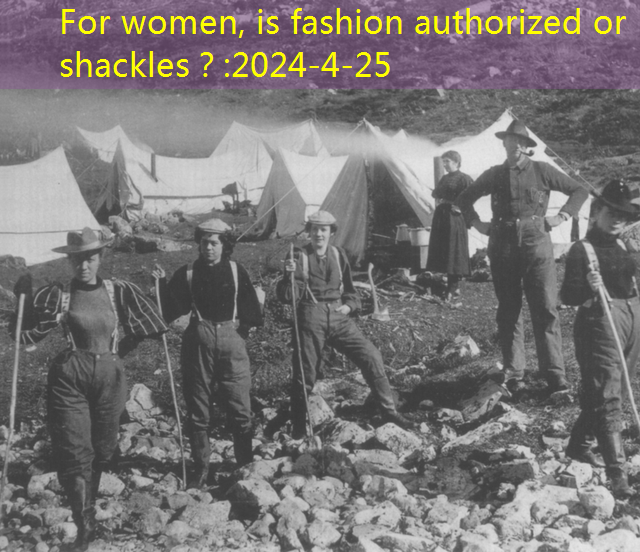
The actresses are wearing men’s pants, strap pants, boots, and men’s hats.Photos are provided by publishers.
Workers’ class women have entered a very eye -catching occupation (such as post office staff and passenger drivers). They use feminine ways (that is, not wearing trousers) to wear male companion uniforms. This situation is often photographed.In 1907, the first batch of women’s long -distance buses in Paris became the theme of postcards. They wore men’s hats and men’s coats.In contrast, during the First World War, nearly 500,000 French women worked in the national defense industry. Many of them would wear work clothes outside wide -leg pants or work clothes, but they were still “invisible”of.According to Robert, “During the war, no illustrations related to the ‘National Defense Industry’ appeared in the mass media.”Drandel and Miller pointed out that this costume “is not successful in the bourgeoisie; therefore, wearing trousers is still a phenomenon limited to the factory.”
Gender, dress and public space of the 20th century
In general, the middle class and high society of these three countries are more in line with cultural specifications related to gender expression than the working class in terms of dressing and appearance.The role of pants in the 19th century women’s clothing reflects the different attitudes of middle class and working class women.The culture of the Victorian era associated pants with male authority.Clothing reformers tried to convince women in high society to wear trousers, but they did not work in general, maybe because people think that women in trousers attempts to usurp male authority.In the 19th century, even in “secluded” public places, women in high society would wear pants only when skirts were covered.Workers’ class women are easier to accept pants.
From the middle of the 19th century to the end of the 19th century, more and more women began to accept men’s clothing, but until the 20th century, women could not wear trousers to overcome them.This change of dress -up specifications first appeared in hidden public places related to leisure, and also reflected in the working class women’s groups in the workplace.At the end of the First World War, the workers -class women who became artists and photographers models in Montanas and Montmartre have begun wearing pants, although this costume is obviously in the streets and cafes in ParisNo.These women are affiliated with the Bohemian culture of the city, and some of them also play the role of “fashion leader”.French designer Chanel in the 20th century tried to popularize pants among women in the middle class and high society, but it was not successful.French women did not develop in the direction of incorporating men’s clothing in women’s clothing. Instead, they were more inclined to “mascum” the female body: depressed chest lines and waist circumference, and cut their hair.Women will go to men’s barber shops with very short and masculine hairstyles, such as Bobit, Shingle, and Eaton.The public’s response to these changes is very negative.Given that other types of changes have taken place very slowly, short hair has become the focus of fierce debate in French women in terms of gender and individual identity.
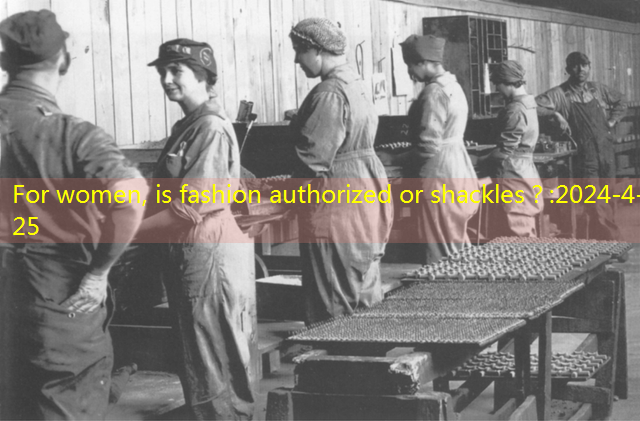
Workers in military factories in large work clothes (1916, the United States).Photos are provided by publishers.
In France in the 1930s, rich women will wear trousers in resort, but they rarely wear it in cities.It is extremely strict for the decent specifications wearing on the streets of the city.Some oral history shows that even in the summer, it is unable to wear a hat, gloves or not to wear socks.There are no women on the street.During the Second World War, people often wore pants due to the scarcity of various new clothing, but it was not until the mid -1950s that the pants began to integrate into the city’s life.
In the UK, World War II has accelerated the popularity of casual pants in terms of work and leisure.The uniforms of the Army’s female soldiers include tie, knee horse pants or denim trousers.Demali quoted the description of London in 1943: “Evelyn Waury) described in London:” A girl with a movie star hairstyle, wearing casual pants and high heels go out with soldiers. “During the war, pants began to start in the war.It was accepted by the workers’ class women, but it was not until the 1960s that the trousers began to be included in the French designer’s fashion series that middle -class women gradually accepted.
In the United States, women in the middle class and high society are mainly wearing pants in a secluded public place (such as pasture and resort) during the war.In the 1930s, several seemingly contradictory trends gathered together, prompting people to wear pants more frequently in leisure activities.Resort pastants have become the most popular tourist destinations in the middle class, which in turn has led to the appearance of female workers’ clothes.At the same time, Hollywood movies, which had an important impact on clothing fashion at the time, depicting many heroines who were both powerful and “masculine”.The heroines of Marlene Dietrich’s writing are “special fads”, and they may be the most influential representative in this image.Fisher believes that the Great Depression in the 1930s was both a social crisis and an economic crisis, which caused a deep anxiety for people’s identity (especially gender identity).She claims that the mainstream concepts of masculinity and feminine temperament during this period are constantly changing.
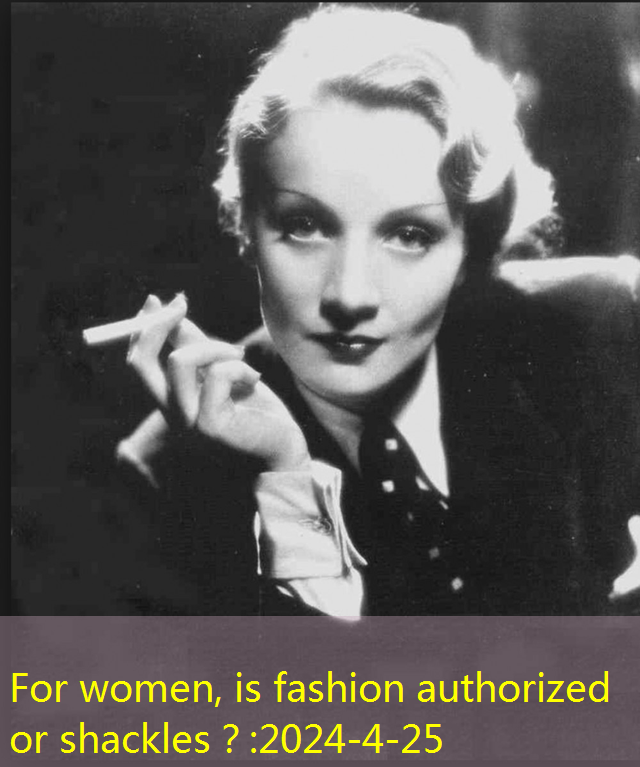
Old actor Marin Dedeli in the 1930s.
However, the workers’ class women gradually incorporate their pants into their daily life.From the product catalog and photos of Sears in the 1940s, it can be seen that the United States’ general acceptance of pants began in the west (especially the worker class women in California), and gradually spread to the east and in the 1950s to the East and the 1950s.The middle class has reversed the trend of fashion changes from the east to the west.Olian pointed out: “More and more sportswear is characterized by casual pants. They originated in California, because they are in line with the west coast of unrestrained lifestyle, so they are very popular in work or entertainment.”The Second World War is represented by the female image of the heavy industry, and this trend has been strengthened in the early stage.There are more women engaged in industry than ever, and their uniforms usually include “loose pants, shirts, and shading caps made of corresponding fabrics.”Others wearing jeans and work clothes.
As the 19th century, feminists in the late 1960s and 1970s resolutely opposed fashion.French feminist Simona De Polka has played an important role in shaping feminist fashion concepts.Unlike their predecessors, they have more criticism of the “manipulating sexual discourse” behind the costume style than the clothing itself.In the United States, the first large -scale female liberation demonstration was aimed at the 1968 Miss American beauty pageant, especially to oppose the stereotype of gender objects represented by the competition.
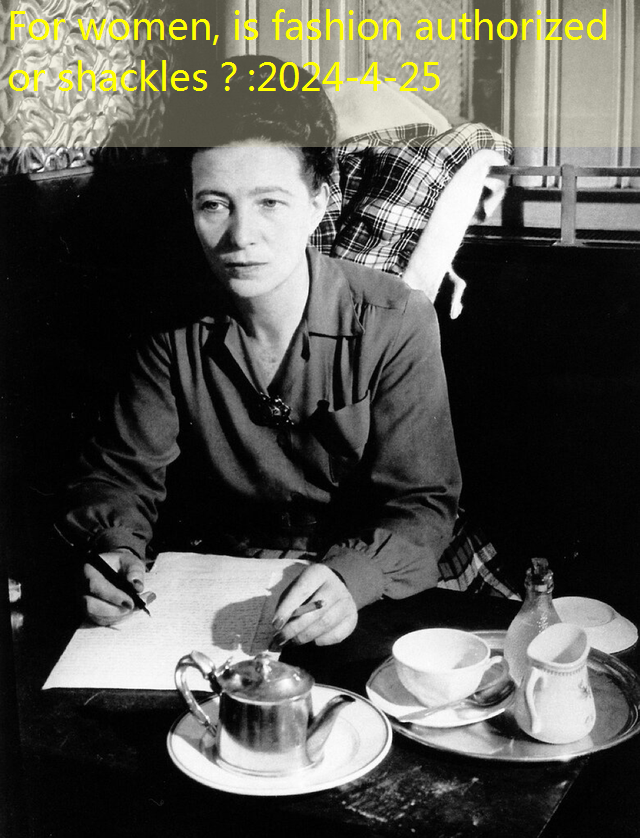
Simona De Bolkwa old photos.
Like the predecessors of the 19th century again, feminists in the 1970s also advocated that they replaced fashion styles with alternative style dressing, especially various pants, and paired with other simple and leisure costumes (such as T -shirts and low heels.shoe).In the United States, lesbians among feminists are the most resolute opposition to any attempts related to individuals or body display.They are wearing loose jeans and hypertrophic jackets, with men’s T -shirts or work shirts, and men’s work boots or sports shoes, reject cosmetics, jewelry and traditional hairstyles.This type of clothing is not so extreme to match the jeans and corresponding accessories, and to form a more “decent” shape.Many non -female gays of feminists wear dresses and long skirts, or wearing tight pants and short skirts in resort; their appearance is very similar to non -feminists among middle -class women.Although in the early 1970s, people’s hugs of women and feminists had great hostility and ridicule, but in just ten years, their attitude towards this “style” never changed to catering, or even it even made them.As a typical casual outfit of young middle -class women.The extensive acceptance of middle -class women’s wide acceptance of pants seems to be initiated by the edge groups (especially lesbian feminists).
In the late 20th century, people did not allow middle -class professional women and business women to wear completely masculine costumes, but still hoped that they could retain feminine elements in the office dress.In the 1920s, short skirt -style suits appeared, but almost no change in the following decades.In the workplace of middle -class companies, although female supervisors will wear jeans and all kinds of trousers in leisure activities, the contraindications of trousers still exist.According to the company’s dressing specifications that may not be clearly defined, they may wear alternative costumes of modern styles in the 19th century, including suit jackets and skirts, men’s shirts or silk shirts, and the clothing is neutral and conservative in terms of overall clothing.However, people now think that such clothing is conservative rather than rebellion.At the same time, it is considered that the fashionable and feminine or sexy appearance is decent.
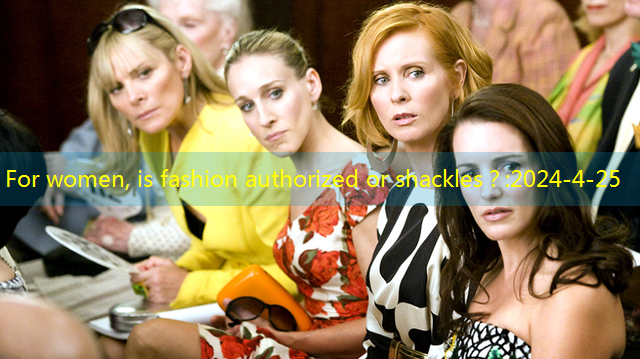
Stills of American drama “Desire City”.
This is in stark contrast to female employees of the working class.They often wear uniforms almost the same as men.During the post -war period, women’s masculinity uniforms gradually appeared in their job occupation similar to men.In the 1940s, British transport female workers were dressed in male uniforms.The U.S. Congress revised the Civil Rights Act in 1972 to prohibit gender discrimination from states and local governments. Subsequently, the US police department adopted masculine women’s uniforms.Since 1973, police departments from all over the United States will grant the same task to women and men, and have a decent dress.The trousers replaced the skirt, which formed a uniform that is very similar to men (including ties, sun hats and pants).Subsequently, professionals such as railway flight attendants, nurses, and stewardess were all equipped with uniforms common to men and women.Similar changes have taken place in France, and the restrictions on women’s pants in the past have disappeared.However, in the higher class of these occupations, people find that if we wear pants in the workplace of the middle -class company, there will still be contradictory psychology.At work, the degree of women’s adaptation to male culture is different because they are allowed or required to be “assimilated”.
Tie was a symbol of women’s liberation and challenging male social status in the 19th century. At the end of the 20th century, it made different meaning due to the different occasions and the wearer.In advertising, fashion magazines and movies, it has always been a symbol of women’s independence.In the luxury costumes specially designed by designers for women who are facing the upper stream society, the tie occasionally is used to show or imitate female authority.In a advertisement in Ralph Lauren, the woman was wearing a tie and compared with her two male companions.But this has not been effectively implemented.In the early 1980s, collar ties were very popular among female executives. Presumably, it must be a reflection of the more peaceful feminism.In contrast, ties that often appear in the workers’ class women’s uniforms, both public (military) or private (aviation and railway companies) have lost these connotations, which seems to reflect women in certain bureaucratic agencies and companiesConventional assimilation in the level system.
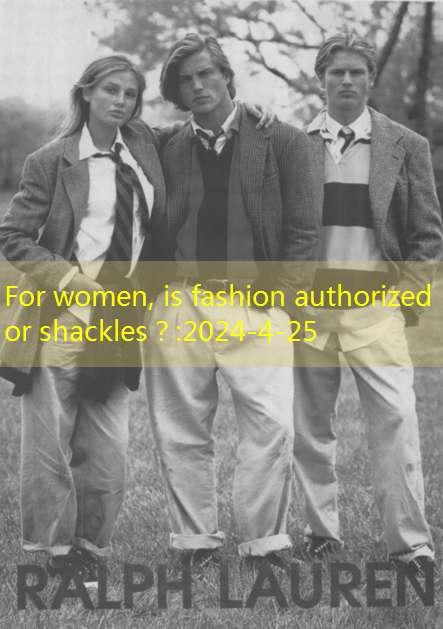
In the imitation of the tie, and using this as a female independent statement, the female model who crooked the tie was in sharp contrast to her male accompany.Photos are provided by publishers.
Original Author | [戴] Diana Calan
Excerpt | Qingqingzi
Edit | Go for a walk
Introduction School Delivery | Li Ming
Report/feedback

